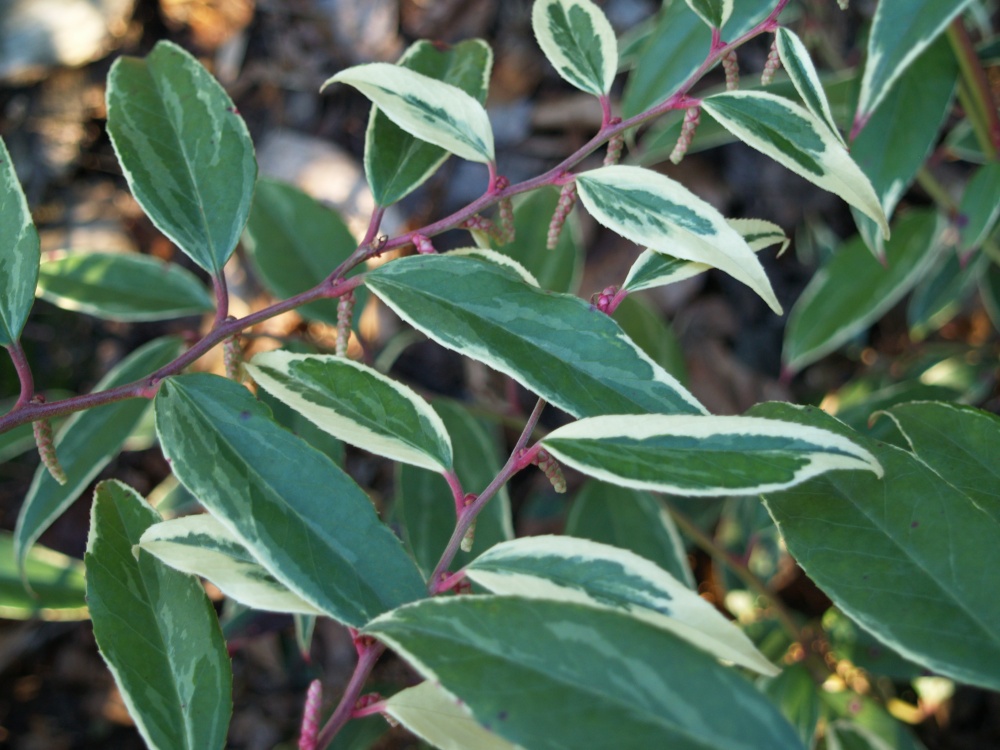Yes, there will be something flowering everyday through this winter, but no matter how wonderful, the gardener is not fully satisfied with only witch hazels (Hamamelis) and an occasional snowdrop (Galanthus) flowering for weeks through January and February. In this winter that was off to a mild beginning before snow buried the garden, there are flowering hellebores, winter jasmines, snowdrops, and winter daphnes (Daphne odora ‘Aureomarginata’, below) that show a peek of color. But, through the long winter the gardener must have more.
With constant foliage that is little changed from May to January, evergreens are more treasured in winter when deciduous trees and shrubs are bare, and there are fewer flowers competing for the gardener’s attention. Certainly, there are folks who do not care for variegated foliage, and designers caution that too much can discomfort the eye. I suspect that I have overdone it in this garden, but there is no more beautiful foliage than the variegated English holly (Ilex aquifolium ‘Argenteo marginata’, below) on a gray winter afternoon. The holly would be more splendid if I had planted a male pollinator, but berries on other green leafed hollies in the garden must suffice.
I have mixed feelings on two variegated forms of leucothoe in the garden. Though it grows without complaint, I have never mustered much enthusiasm for the common ‘Rainbow’ leucothoe (Leucothoe fontanesiana ‘Rainbow’, below). There are plants that suit the gardener’s eye, others that don’t. I have planted ‘Rainbow’ in two gardens. In the first I knew little, expected more, and was disappointed. In this garden, I don’t recall, but I suspect I planted one that had been discarded, since there is no purpose in paying good money for a plant that doesn’t please you. I will plant just about anything that is free, and so, here it is, and no matter that I am not particularly fond of it. Certainly, there are greater sorrows for the gardener to bear. 
Though less common, and perhaps lacking in excitement by comparison, I greatly prefer the variegated Coast leucothoe (Leucothoe axillaris ‘Variegata’, below). Its foliage has greater substance, and its branches arch somewhat more gracefully than ‘Rainbow’. No doubt, I am of the minority opinion, but the Coast leucothoe is a more elegant choice. Both work superbly in light shade, though of course the Coast leucothoe is preferable. 
‘Silver Edge’ rhododendron (below) was planted early last year, and, as is routine for rhododendron growers, buds were snapped off to encourage faster growth. So, no flowers last year, but a few are expected by late spring, though buds are not yet prominent. Perhaps it will not flower this year, but it has been given a prominent spot with the superb drainage that rhododendrons require in clay soil, so I expect it will be a fine addition to the garden.


There are a handful or two of Japanese aucuba (Aucuba japonica) in the garden, one green leafed, and others splashed with gold speckles or blotches. The best of these are the gold dusted types, the excellent and very common ‘Gold Dust’ (above) and several selections noted for larger and brighter speckles. ‘Picturata’ (below) does not have stable variegation, and any plant is likely to have leaves with large gold areas as well as other leaves that are speckled. The aucubas are excellent, slow growing evergreens well suited for shaded areas, and as holds true for many broadleaf evergreens without spines, aucubas must be protected from deer through the winter months or a large shrub might be eaten down to bare stems. A single spray with a repellent in November does the trick.

The andromedas (Pieris spp.) are excellent evergreens with panicles of late winter flowers, though they are very picky about drainage and must be provided with soil that is extremely well drained. This is a challenge in clay soils, but I’ve managed to keep several alive for a few decades (though several have been lost) by keeping to the high side and avoiding areas that are obviously moist. Two with variegated foliage, ‘Little Heath’ (below) and ‘Flaming Silver’ are as tolerant of the clay as any. ‘Flaming Silver’ is a magnet for lacebugs, even in the shade where the bugs are less prone to be a bother, and I can attest that as minor a nuisance as lacebugs are, an infestation over a period of years will cost a stem here and there until the result is rather sad.

The variegated false holly (Osmanthus heterophyllus ‘Goshiki’, below) is a sturdy evergreen, slow growing but not bothered by deer or other pests. I am waiting patiently for it to fill a space vacated by a long forgotten something that was dug out several years ago. At some point, if I should be around long enough, ‘Goshiki’ will also become a treasured variegated evergreen through the winter months.
